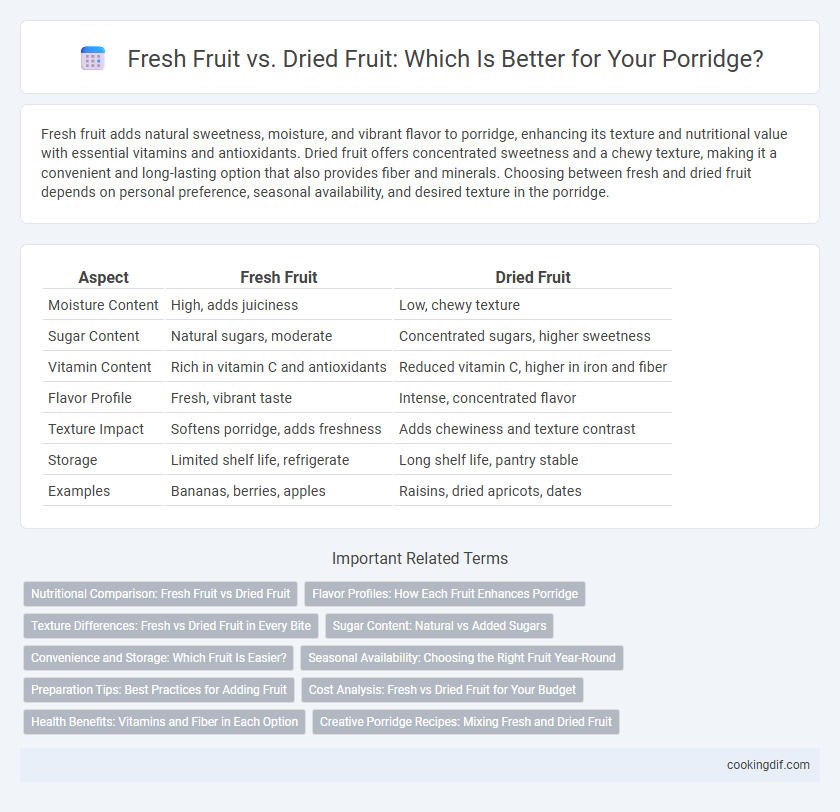Fresh fruit adds natural sweetness, moisture, and vibrant flavor to porridge, enhancing its texture and nutritional value with essential vitamins and antioxidants. Dried fruit offers concentrated sweetness and a chewy texture, making it a convenient and long-lasting option that also provides fiber and minerals. Choosing between fresh and dried fruit depends on personal preference, seasonal availability, and desired texture in the porridge.
Table of Comparison
| Aspect | Fresh Fruit | Dried Fruit |
|---|---|---|
| Moisture Content | High, adds juiciness | Low, chewy texture |
| Sugar Content | Natural sugars, moderate | Concentrated sugars, higher sweetness |
| Vitamin Content | Rich in vitamin C and antioxidants | Reduced vitamin C, higher in iron and fiber |
| Flavor Profile | Fresh, vibrant taste | Intense, concentrated flavor |
| Texture Impact | Softens porridge, adds freshness | Adds chewiness and texture contrast |
| Storage | Limited shelf life, refrigerate | Long shelf life, pantry stable |
| Examples | Bananas, berries, apples | Raisins, dried apricots, dates |
Nutritional Comparison: Fresh Fruit vs Dried Fruit
Fresh fruit adds hydration and fewer calories to porridge, offering essential vitamins like vitamin C and antioxidants with lower sugar content. Dried fruit, while more calorie-dense and higher in natural sugars, provides concentrated fiber, iron, and potassium, enhancing the porridge's energy and mineral profile. Choosing between fresh and dried fruit depends on nutritional goals, such as calorie control or increased nutrient density.
Flavor Profiles: How Each Fruit Enhances Porridge
Fresh fruit adds a vibrant, juicy sweetness and natural acidity to porridge, enhancing its creamy texture with bright, refreshing flavor notes such as berries' tartness or banana's mellow richness. Dried fruit contributes concentrated sweetness and chewy texture, intensifying the porridge's warmth and depth with caramelized flavors like raisins' earthiness or apricots' tangy sweetness. Combining both fresh and dried fruits balances moisture and sweetness, creating a complex flavor profile that elevates the overall taste experience of porridge.
Texture Differences: Fresh vs Dried Fruit in Every Bite
Fresh fruit adds a juicy, tender texture to porridge, creating a refreshing contrast with the creamy oats, while dried fruit offers a chewy, concentrated sweetness that infuses each spoonful with intense flavor. The moisture content in fresh fruit softens the porridge, enhancing smoothness, whereas dried fruit's firmness provides a more substantial bite and prolonged texture experience. Choosing between fresh and dried fruit depends on whether a light, hydrating texture or a rich, chewy consistency is preferred.
Sugar Content: Natural vs Added Sugars
Fresh fruit adds natural sugars like fructose and glucose, which are metabolized more slowly and provide vitamins, fiber, and antioxidants essential for health. Dried fruit contains concentrated natural sugars due to dehydration, increasing the glycemic load and calorie content per serving, often with added sugars that elevate overall sugar intake beyond natural levels. Choosing fresh fruit for porridge enhances nutrient density and maintains a lower sugar impact, supporting balanced blood glucose management.
Convenience and Storage: Which Fruit Is Easier?
Fresh fruit offers a natural, juicy flavor but requires refrigeration and has a shorter shelf life, making it less convenient for long-term storage. Dried fruit requires no refrigeration, has a long shelf life, and is easy to store in airtight containers, enhancing convenience for quick porridge additions. For hassle-free storage and immediate use, dried fruit is the easier option compared to fresh fruit.
Seasonal Availability: Choosing the Right Fruit Year-Round
Fresh fruit offers vibrant flavors and higher water content, making it an ideal porridge addition when in season, typically spring and summer for berries, apples, and stone fruits. Dried fruit, such as raisins, apricots, and dates, provides a concentrated sweetness and a longer shelf life, making it a practical choice during autumn and winter months when fresh options are limited. Balancing fresh and dried fruits ensures nutrient variety and consistent availability, enhancing porridge's taste and texture throughout the year.
Preparation Tips: Best Practices for Adding Fruit
Fresh fruit for porridge adds a burst of natural sweetness and moisture but should be chopped into small, even pieces to ensure even distribution and easier eating. Dried fruit requires soaking in warm water or milk for at least 10-15 minutes before adding to soften and rehydrate, preventing a chewy texture. Balancing the moisture content by adjusting the liquid in the porridge recipe helps maintain creamy consistency when incorporating either type of fruit.
Cost Analysis: Fresh vs Dried Fruit for Your Budget
Choosing fresh fruit for porridge offers a lower upfront cost and provides essential hydration, but it has a shorter shelf life, leading to potential waste and repeated purchases. Dried fruit, while typically more expensive per ounce, has a longer shelf life and concentrated sweetness, offering cost efficiency over time with less spoilage. Comparing price per serving and storage needs reveals dried fruit may better suit budget-conscious consumers seeking convenience, whereas fresh fruit demands frequent shopping and prompt use to maximize value.
Health Benefits: Vitamins and Fiber in Each Option
Fresh fruit additions to porridge provide higher levels of vitamin C and antioxidants, which support immune function and skin health, along with natural hydration due to their water content. Dried fruit offers a concentrated source of fiber and essential minerals like iron and potassium, promoting digestive health and sustained energy release, although it contains more sugars per serving than fresh fruit. Choosing between fresh and dried fruit for porridge depends on balancing vitamin intake and fiber needs while considering sugar content for overall health benefits.
Creative Porridge Recipes: Mixing Fresh and Dried Fruit
Combining fresh and dried fruit in porridge enhances flavor complexity and nutritional value, providing natural sweetness alongside texture contrast. Fresh berries, apples, or bananas add juiciness and vital vitamins, while dried fruits like raisins, apricots, or cranberries contribute concentrated sugars and chewy bites. Creative porridge recipes blend these fruits to balance moisture, sweetness, and fiber, creating a satisfying morning meal rich in antioxidants and essential nutrients.
Fresh fruit vs dried fruit for porridge additions Infographic

 cookingdif.com
cookingdif.com